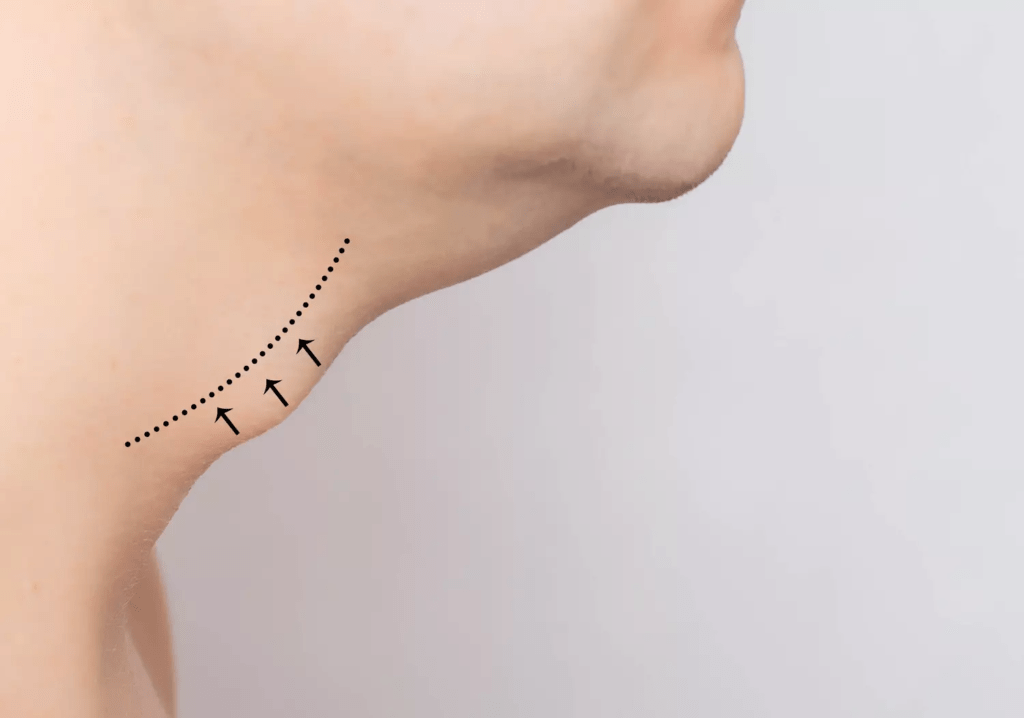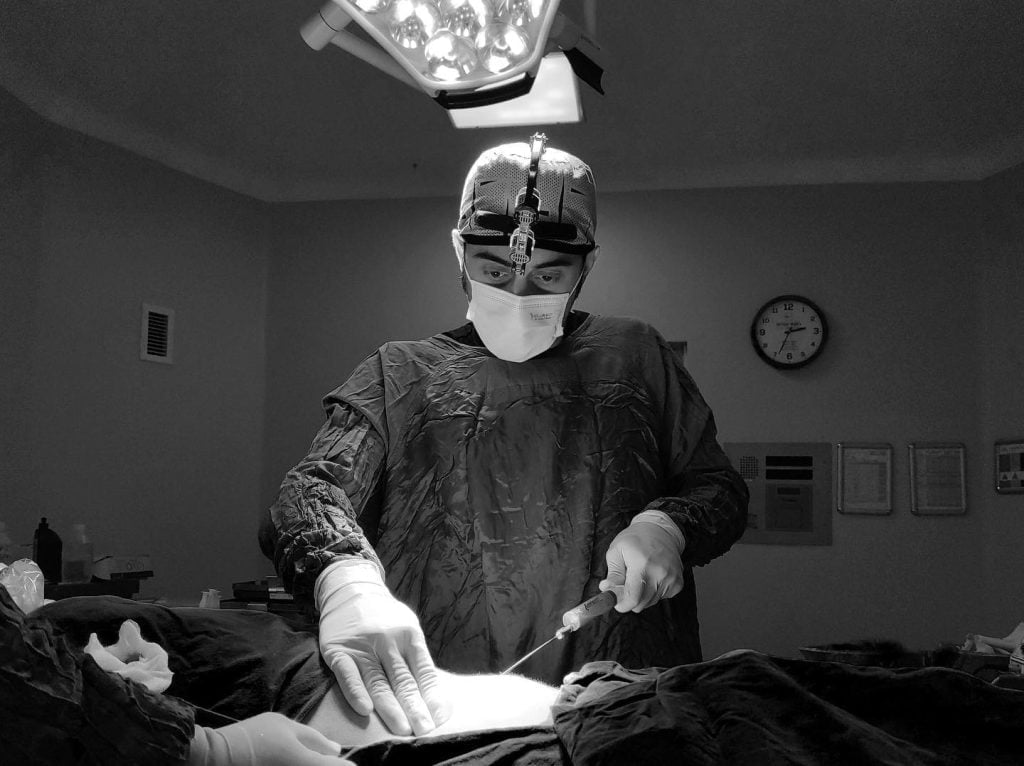If you are a trans woman who wants to change your appearance and voice, you may have considered having surgery to reduce your Adam’s apple and feminize your vocal cords. These are two common procedures that can help you achieve a more feminine look and sound. But what exactly are they, how do they work, and what are the benefits and risks of each one? In this article, we will explain everything you need to know about Adam’s apple reduction and voice feminization surgery.

Table of Contents
What is an Adam’s Apple?
The Adam’s apple is the name given to the prominent swelling on the front of your neck that is caused by the thyroid cartilage. The thyroid cartilage is a piece of tissue that protects your larynx, which is the organ that contains your vocal cords. The vocal cords are two bands of muscle that vibrate when you speak or sing, producing sound.
The size and shape of your Adam’s apple can vary depending on several factors, such as genetics, hormones, age, weight, and posture. Generally speaking, women tend to have smaller and less protruding Adam’s apples than men, because they have less testosterone in their bodies. Testosterone is a hormone that stimulates the growth of the thyroid cartilage during puberty.
However, some women may still have larger or more noticeable Adam’s apples due to other reasons. For example, some women may have inherited a larger thyroid cartilage from their fathers or mothers. Some women may also develop an enlarged thyroid cartilage due to certain medical conditions or medications that affect their hormone levels.
An enlarged or protruding Adam’s apple can cause some problems for trans women who want to change their appearance and voice. For instance, an Adam’s apple can make it harder for trans women to find clothes that fit well on their necks. It can also make it more difficult for trans women to hide their necks under certain hairstyles or accessories. Moreover, an Adam’s apple can affect how other people perceive trans women in terms of their gender identity and expression.
What is Voice Feminization Surgery?
Voice feminization surgery is a type of surgery that aims to modify the structure and function of your vocal cords in order to produce a higher-pitched voice. A higher-pitched voice is typically associated with femininity in most cultures.
There are different ways to achieve voice feminization surgery, depending on your goals and preferences. One way is to use injections or implants that alter the length or tension of your vocal cords. Another way is to use devices or exercises that stretch or relax your vocal cords over time.
However, these methods may not be very effective or permanent for some trans women who want more dramatic changes in their voice quality and pitch. That’s why some trans women opt for voice feminization surgery instead.
Voice feminization surgery involves making incisions inside your mouth or throat and cutting or rearranging parts of your vocal cords. The most common procedure for this purpose is called tracheal shave (also known as chondrolaryngoplasty). This procedure involves shaving down the front part of your thyroid cartilage with a special tool called a burr.
By doing this, you can reduce the size and prominence of your Adam’s apple at the same time as you alter the shape and position of your vocal cords. This can result in a flatter neckline and a higher-pitched voice.
What are the Benefits of Adam’s Apple Reduction?
Adam’s apple reduction has several benefits for trans women who want to change their appearance and voice. Some of these benefits are:
- It can improve how you look by making your neck look more slender and graceful.
- It can enhance how you feel by boosting your self-confidence and self-esteem.
- It can make it easier for you to dress according to your personal style.
- It can help you avoid unwanted attention or harassment from others based on your neck size.
- It can allow you to express yourself more freely without worrying about hiding or covering up your neck.
What are the Risks of Voice Feminization Surgery?
Voice feminization surgery also has some risks that you should be aware of before deciding whether it is right for you. Some of these risks are:
- It can cause complications such as bleeding, infection, scarring, nerve damage, vocal cord paralysis, hoarseness, loss of range or quality
- It can require additional procedures such as tracheal shave revision (to correct any asymmetry), laryngeal suspension (to balance out any asymmetry), laryngeal shave augmentation (to increase volume), laryngeal shave implantation (to add volume)
- It can affect other aspects of your health such as breathing difficulty
- It can have psychological effects such as regret
- It can be expensive
How Much Does Adam’s Apple Reduction Cost?
The cost of Adam’s apple reduction depends on several factors such as where you live, where you get it done, who performs it, what technique is used, and whether you combine it with other procedures. According to some estimates, the average cost of Adam’s apple reduction in the US ranges from $3,000 to $10,000. In Europe, the average cost is around €2,500 to €5,000. In Asia, the average cost is around $1,000 to $3,000.
However, these are only rough figures that may vary depending on your specific situation and needs. Therefore, it is important to consult with a qualified surgeon who can give you a personalized quote based on your goals and expectations.
How to Prepare for Adam’s Apple Reduction?
Before you undergo Adam’s apple reduction, you need to prepare yourself physically and mentally for the surgery. Here are some steps that you should follow to get ready for the procedure:
- Find a reputable surgeon who has experience and expertise in performing Adam’s apple reduction and voice feminization surgery. You can do some research online, ask for recommendations from other trans women who have had the surgery, or contact a local transgender support group for guidance.
- Schedule a consultation with your chosen surgeon to discuss your medical history, current health condition, medications, allergies, and expectations. Your surgeon will examine your neck and throat, measure your vocal pitch and quality, and explain the details of the surgery, including the risks, benefits, complications, and recovery process. You will also have the opportunity to ask any questions that you may have and voice any concerns that you may feel.
- Follow your surgeon’s instructions regarding how to prepare for the surgery. You may need to stop taking certain medications, supplements, or herbal remedies that can interfere with the surgery or increase the risk of bleeding. You may also need to quit smoking, drinking alcohol, or using recreational drugs at least two weeks before the surgery, as they can affect your healing and recovery. You may also need to fast for a few hours before the surgery, depending on the type of anesthesia that will be used.
- Arrange for someone to drive you to and from the hospital or clinic where the surgery will take place. You will not be able to drive yourself after the surgery, as you will be under the influence of anesthesia and painkillers. You will also need someone to stay with you for the first 24 hours after the surgery, as you may need help with basic tasks such as eating, drinking, or going to the bathroom.
- Pack a bag with some essentials that you will need after the surgery, such as comfortable clothes, a pillow, a scarf, a water bottle, a straw, a soft toothbrush, a mouthwash, some ice packs, some painkillers, and some books or magazines to keep you entertained. You may also want to bring some personal items that can make you feel more comfortable and relaxed, such as a favorite blanket, a stuffed animal, or a photo of a loved one.
What to Expect After Adam’s Apple Reduction?
After you have Adam’s apple reduction, you will need to follow some post-operative care instructions to ensure a smooth and successful recovery. Here are some things that you can expect after the surgery:
- You will be taken to a recovery room where you will be monitored by medical staff until you wake up from the anesthesia. You may feel some pain, discomfort, swelling, bruising, or numbness in your neck and throat area. You may also have some difficulty swallowing, speaking, or breathing. These are normal and temporary side effects that will subside gradually over time. You will be given some painkillers and antibiotics to ease the pain and prevent infection. You will also be given some instructions on how to care for your incision site, such as keeping it clean and dry, applying some ointment, and changing the dressing regularly.
- You will be able to go home the same day or the next day, depending on your condition and your surgeon’s advice. You will need to rest and avoid any strenuous activities for at least a week. You will also need to avoid any pressure or trauma to your neck and throat area, such as wearing tight collars, scarves, or necklaces, or sleeping on your side or stomach. You will also need to avoid any exposure to sunlight, heat, or cold, as they can affect your healing and scar formation. You will also need to avoid any smoking, drinking alcohol, or using recreational drugs, as they can impair your healing and recovery.
- You will need to follow a soft or liquid diet for the first few days after the surgery, as you may have some difficulty chewing or swallowing solid foods. You will also need to drink plenty of fluids to stay hydrated and prevent dehydration. You will also need to avoid any spicy, acidic, or hot foods or drinks, as they can irritate your throat and vocal cords. You will also need to avoid any coughing, sneezing, or clearing your throat, as they can strain your throat and vocal cords. You will also need to avoid any speaking, singing, or shouting, as they can damage your vocal cords and affect your voice quality and pitch.
- You will need to visit your surgeon for regular follow-up appointments to check your progress and healing. Your surgeon will remove your stitches or dissolvable sutures after about a week. Your surgeon will also evaluate your voice and give you some exercises or therapy to improve your vocal pitch and quality. You will also be able to see the final results of your surgery after about three to six months, when the swelling and bruising have subsided and the scar has faded.

Conclusion
Adam’s apple reduction and voice feminization surgery are two procedures that can help trans women achieve a more feminine appearance and voice. They can have many benefits for trans women who want to change their gender expression and identity. However, they also have some risks and complications that should be considered carefully before deciding to undergo them. Therefore, it is important to consult with a qualified surgeon who can provide you with the best advice and care for your specific needs and goals.
Visit the Dr.MFO Instagram profile for examples of successful Surgeries. Contact for free consultation.
Why You Should Choose Dr. MFO for Adam’s Apple Removal Surgery and Voice Feminization Surgery
If you are looking for a facial feminization surgeon who can help you achieve your desired look and voice, you should consider Dr. MFO. Dr. MFO is a European and Turkish board certified plastic surgeon who has over 10 years of experience in performing thousands of successful surgeries. He is also an authorized international health tourism center, which means he can offer you high-quality care at an affordable price.
Dr. MFO specializes in both Adam’s apple removal surgery and voice feminization surgery, which are two of the most common procedures for people who want to change their appearance and voice to match their gender identity.
What is Adam’s Apple Removal Surgery?
Adam’s apple removal surgery, also known as tracheal shave or chondrolaryngoplasty, is a surgical procedure that reduces the size and prominence of the thyroid cartilage in the neck. The thyroid cartilage is the bony structure that surrounds the larynx, which contains the vocal cords. The larynx is responsible for producing sound when air passes through it.
Adam’s apple removal surgery can improve the neck appearance of trans women by making their throat look more feminine and less masculine. It can also make it easier to wear certain types of clothing or accessories that may otherwise be uncomfortable or restrictive due to the large Adam’s apple.
Adam’s apple removal surgery is usually performed under general anesthesia and takes about an hour to complete. The incision is made across the front of the neck, usually from earlobe to earlobe, and then the thyroid cartilage is shaved off with a scalpel or a laser. The wound is closed with stitches or staples and covered with a bandage.
The recovery time for Adam’s apple removal surgery varies depending on individual factors, such as age, health, and healing ability. Generally, it takes about two weeks to heal completely and resume normal activities. Some possible complications include bleeding, infection, scarring, nerve damage, or vocal cord injury.
What is Voice Feminization Surgery?
Voice feminization surgery is a surgical procedure that modifies the length and space between the vocal cords to lower the pitch of your voice. The vocal cords are two thin bands of tissue that vibrate when air passes through them. The pitch of your voice depends on how fast or slow these vibrations are.
Voice feminization surgery can help trans women achieve a more feminine voice that matches their gender identity and expression. It can also improve their self-confidence and social interactions by reducing dysphoria or discomfort caused by having a deep or harsh voice.
Voice feminization surgery is usually performed by an ear-nose-throat (ENT) surgeon under general anesthesia and takes about two hours to complete. The incision is made inside the mouth or behind the earlobe, depending on where you want your new vocal cords to be located. Then, one or both vocal cords are cut into smaller pieces with scissors or lasers to reduce their length and increase their space between them. The wound is closed with stitches or staples and covered with a bandage.
The recovery time for voice feminization surgery also varies depending on individual factors. Generally, it takes about three weeks to heal completely and resume normal activities. Some possible complications include bleeding, infection, scarring, nerve damage, hoarseness, breathiness, or loss of voice quality.

Why Choose Dr. MFO?
Dr. MFO has extensive experience in performing both Adam’s apple removal surgery and voice feminization surgery with excellent results. He has performed hundreds of these procedures for his patients from different countries around the world who came to him as international health tourists.
Dr. MFO uses advanced techniques and equipment to ensure safety and quality in his surgeries. He follows strict infection control protocols and uses sterile instruments during his operations. He also uses lasers instead of scalpel blades to minimize bleeding and scarring during his tracheal shave procedures.
Dr. MFO offers personalized care and attention to his patients before, during, and after their surgeries. He listens to their expectations and goals carefully and provides them with honest advice on what they can expect from each procedure. He also educates them on how to prepare for their surgeries properly by following his instructions on dieting, medication use, wound care, etc.
Dr. MFO provides comprehensive support services for his patients after their surgeries as well. He offers them follow-up consultations regularly to monitor their progress and address any concerns they may have. He also provides them with post-operative care instructions such as pain management medications
FAQ
1. What is an Adam’s apple?
An Adam’s apple is a protrusion in the neck that is more prominent in males. It’s part of the thyroid cartilage surrounding the larynx (voice box).
2. Why is it called an Adam’s apple?
The term “Adam’s apple” comes from a biblical reference to the forbidden fruit that Adam ate in the Garden of Eden, which was said to have stuck in his throat.
3. Do all males have an Adam’s apple?
Yes, all males have an Adam’s apple, but its size and prominence vary. Some may have a larger and more visible Adam’s apple than others.
4. Why is the Adam’s apple more prominent in males?
The Adam’s apple is more prominent in males due to the growth of the larynx during puberty. This growth is influenced by testosterone, a hormone more abundant in males.
5. Can females have a visible Adam’s apple?
Yes, females also have an Adam’s apple, but it’s usually smaller and less visible than in males. However, some females may have a more noticeable Adam’s apple.
6. What causes an Adam’s apple to develop?
The development of the Adam’s apple is linked to the changes in the larynx that occur during puberty. These changes are influenced by sex hormones, particularly testosterone.
7. At what age does the Adam’s apple typically develop?
The Adam’s apple typically develops during puberty, which usually starts between ages 9 and 14 for boys.
8. Can the size of the Adam’s apple be reduced?
Yes, the size of the Adam’s apple can be reduced through a surgical procedure known as a tracheal shave or chondrolaryngoplasty.
9. Is there a surgery to remove the Adam’s apple?
Yes, a surgical procedure known as a tracheal shave or chondrolaryngoplasty can reduce the size of the Adam’s apple. Complete removal is not typically done due to the risk of damaging the voice box.
10. What is the function of the Adam’s apple?
The Adam’s apple protects the walls and the frontal part of the larynx, including the vocal cords. It also moves up and down during swallowing and speaking.
11. Can the Adam’s apple affect one’s voice?
Yes, the size of the Adam’s apple can affect the pitch of the voice. A larger larynx and Adam’s apple can result in a deeper voice.
12. What is the medical term for the Adam’s apple?
The medical term for the Adam’s apple is the laryngeal prominence.
13. Can hormone therapy affect the size of the Adam’s apple?
Hormone therapy can lead to some changes in the body, but it does not typically affect the size of the Adam’s apple.
14. Are there exercises to reduce the size of the Adam’s apple?
There are no known exercises that can reduce the size of the Adam’s apple. Changes to the size or shape of the Adam’s apple would require surgical intervention.
15. Can an injury to the Adam’s apple be dangerous?
Yes, an injury to the Adam’s apple can be dangerous as it could damage the larynx and potentially affect breathing and speaking.
16. How is an Adam’s apple examined by a doctor?
A doctor can examine an Adam’s apple through a physical examination, feeling the neck area for any abnormalities. If necessary, imaging tests like an X-ray or CT scan may be used.
17. Can the size of the Adam’s apple indicate testosterone levels?
While the size of the Adam’s apple is influenced by testosterone, it’s not a reliable indicator of testosterone levels. Many factors, including genetics, contribute to its size.
18. Is the size of the Adam’s apple related to voice depth?
Yes, generally, a larger Adam’s apple (and thus a larger larynx) results in a deeper voice. However, voice depth is also influenced by other factors such as the size and length of the vocal cords.
19. Can weight loss or gain affect the size of the Adam’s apple?
Weight loss or gain can change the appearance of the Adam’s apple. Weight loss can make it more visible, while weight gain can make it less noticeable.
20. Are there non-surgical ways to minimize the appearance of an Adam’s apple?
Non-surgical ways to minimize the appearance of an Adam’s apple include certain hairstyles, clothing choices, and postures that draw attention away from the neck area.
21. Can an Adam’s apple be a sign of any medical conditions?
A prominent Adam’s apple is not typically a sign of any medical conditions. However, changes in its size or shape could indicate a medical issue and should be evaluated by a healthcare professional.
22. How does puberty affect the development of the Adam’s apple?
During puberty, the larynx grows and the cartilage around it hardens, forming the Adam’s apple. This process is influenced by sex hormones, particularly testosterone.
23. Can the Adam’s apple grow during adulthood?
The Adam’s apple typically does not grow during adulthood. Its size and shape are largely determined during puberty.
24. How does the Adam’s apple contribute to swallowing?
The Adam’s apple moves upward when swallowing, which helps close off the larynx to prevent food or liquid from entering the windpipe.
25. Can an Adam’s apple cause discomfort or pain?
Normally, an Adam’s apple does not cause discomfort or pain. However, pain or discomfort could indicate an injury or medical condition that should be evaluated by a healthcare professional.
26. How does the Adam’s apple move during speech?
During speech, the Adam’s apple moves up and down as the vocal cords vibrate and produce sound.
27. Can the Adam’s apple be felt during a physical examination?
Yes, a doctor can feel the Adam’s apple during a physical examination to check for any abnormalities.
28. What cultural or societal beliefs exist about the Adam’s apple?
In some cultures, a prominent Adam’s apple is associated with masculinity. However, societal perceptions can vary widely.
29. Can the Adam’s apple be reshaped for cosmetic reasons?
Yes, surgical procedures such as a tracheal shave can reshape the Adam’s apple for cosmetic reasons.
30. How does the Adam’s apple differ across various ethnic groups?
The size and prominence of the Adam’s apple can vary among individuals of different ethnic groups, likely due to genetic differences. However, more research is needed in this area.




